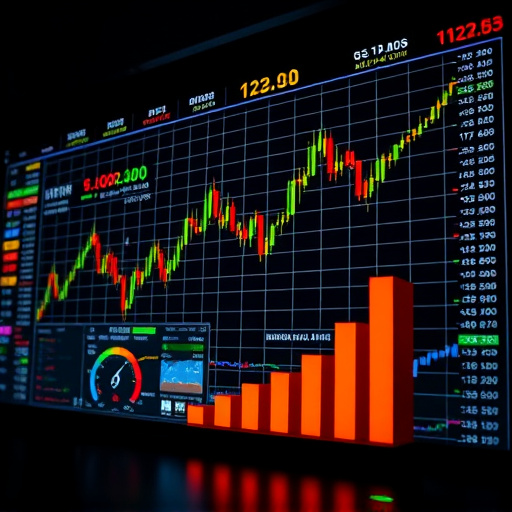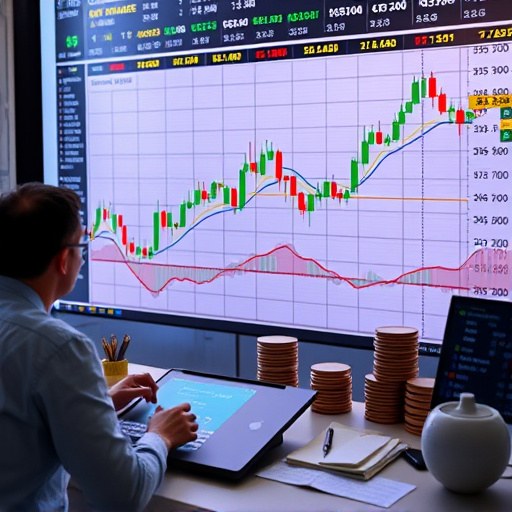Leverage trading amplifies profit potential but increases risk, requiring a delicate balance. Market liquidity, crucial for executing trades efficiently, is enhanced by high liquidity and mitigated by low liquidity. Successful leverage trading involves strategic goal-setting, risk management techniques (stop-loss orders, diversification), market monitoring, and adaptive strategy adjustments to harness gains while minimizing losses in volatile markets.
Market liquidity and leverage are dual forces that significantly shape trading performance. While liquidity ensures smooth buying and selling, leverage amplifies potential returns by allowing traders to control more assets with less capital. However, this power comes with risks, especially in illiquid markets where price movements can be volatile. This article explores the intricate relationship between market liquidity and leverage, offering insights into their interplay and best practices for effective leverage usage in liquid environments, focusing on key strategies and potential pitfalls in leverage trading.
- Understanding Market Liquidity: The Foundation of Trading Success
- Leverage Trading: Unlocking Potential but Carrying Risk
- The Interplay Between Liquidity and Leverage on Trading Strategies
- Navigating the Impact of Leverage on Trading Performance
- Best Practices for Effective Leverage Usage in Liquid Markets
Understanding Market Liquidity: The Foundation of Trading Success

Market liquidity refers to the ease with which financial assets can be bought or sold in a market without significantly impacting their price. It’s a cornerstone for traders, especially those engaging in leverage trading. High liquidity means there are ample buyers and sellers, allowing for quick transactions at reasonable prices. This is crucial for leveraging strategies, where traders borrow funds to increase their buying power, aiming to capitalize on potential price movements.
In the realm of leverage trading, understanding market depth and liquidity levels is essential. Adequate liquidity enables traders to enter or exit positions swiftly, minimizing slippage (the difference between expected and executed prices). It also ensures that they can meet margin requirements, especially during volatile periods. Conversely, low liquidity can hinder these activities, potentially leading to unfavorable trade outcomes. Thus, for successful leverage trading, monitoring market conditions to ensure sufficient liquidity is paramount.
Leverage Trading: Unlocking Potential but Carrying Risk

Leverage trading, a powerful tool in the financial markets, allows investors and traders to amplify their potential returns by borrowing funds from brokers. This strategy can unlock significant gains, especially for those navigating volatile assets. However, it’s not without risks; over-leveraging can lead to substantial losses if market conditions shift against the trader. The key lies in a delicate balance—using leverage wisely to capitalize on opportunities while managing exposure to protect capital.
Traders must understand that with increased leverage comes increased volatility. It amplifies both gains and losses, requiring meticulous risk management. A strategic approach involves setting clear stop-loss orders, diversifying investments, and staying informed about market dynamics. By embracing leverage trading responsibly, investors can navigate the markets more effectively, aiming for substantial returns while mitigating potential setbacks.
The Interplay Between Liquidity and Leverage on Trading Strategies

Market liquidity and leverage are two powerful tools that significantly shape trading strategies. Liquidity, representing the ease with which assets can be bought or sold without affecting their price, acts as a lubricant for efficient trading. High liquidity allows traders to enter or exit positions swiftly, minimizing slippage and transaction costs. This is particularly crucial in volatile markets where rapid decision-making can be the difference between profit and loss.
Leverage trading, on the other hand, amplifies both gains and risks by allowing traders to control a larger position size with a relatively small amount of capital. It enables traders to maximize potential returns by magnifying market movements. However, this also means that losses can grow exponentially. The interplay between liquidity and leverage is delicate; ample liquidity supports effective leverage, while insufficient liquidity can render it risky. Traders must carefully balance these elements to optimize their strategies, ensuring they can execute trades promptly and manage risks appropriately.
Navigating the Impact of Leverage on Trading Performance

Navigating the impact of leverage on trading performance is an art and a science in the dynamic world of financial markets. Leverage trading, while offering the potential for significant gains, can also lead to substantial losses if not managed prudently. The key lies in understanding that leverage amplifies both profits and risks.
Effective risk management becomes paramount when utilizing leverage. Traders must set clear stop-loss orders to limit potential downside exposure and ensure that their position sizes are appropriate for their risk tolerance. By carefully monitoring market movements and adjusting strategies accordingly, traders can harness the power of leverage to enhance their trading performance while mitigating the associated risks.
Best Practices for Effective Leverage Usage in Liquid Markets

In liquid markets, effective leverage trading involves a delicate balance. Firstly, investors should set clear, well-defined goals that align with their risk tolerance and investment horizon. This strategic approach ensures that leverage is not employed haphazardly but as a calculated tool to amplify potential gains. By setting specific targets, traders can judiciously select the level of leverage suitable for each trade, avoiding over-indebtedness and potential ruinous losses.
Best practices also dictate rigorous risk management strategies. This includes establishing stop-loss orders to limit downside exposure and employing position sizing techniques that cap individual trade risks relative to total capital. Regular monitoring of market conditions and adjustments to leverage levels as volatility shifts are paramount. Diversifying the investment portfolio across various asset classes further mitigates risk, enhancing overall resilience in volatile markets while leveraging trading provides opportunities for substantial gains.
Market liquidity and leverage, while powerful tools for traders, require careful navigation. By understanding the interplay between these factors, investors can unlock substantial gains. Leverage trading amplifies profits in liquid markets, but it also increases risk. Balancing these elements through strategic positioning and responsible usage allows traders to maximize returns while mitigating potential losses. Adhering to best practices ensures successful leverage application, ultimately fostering robust trading performance.
